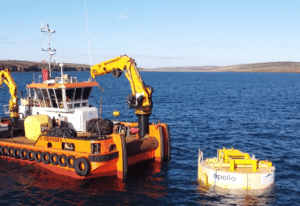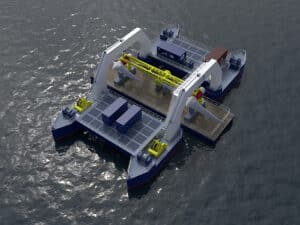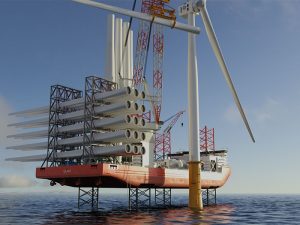
Virginia approves plan for prototype offshore wind turbine installation
Written by Nick Blenkey Virginia Governor Bob McDonnell says that the Virginia Marine Resources Commission has voted unanimously to approve proposed construction of a 479-foot-tall, five-megawatt wind turbine generator prototype in the lower Chesapeake Bay, three miles off the Eastern Shore town of Cape Charles.
Virginia Governor Bob McDonnell says that the Virginia Marine Resources Commission has voted unanimously to approve proposed construction of a 479-foot-tall, five-megawatt wind turbine generator prototype in the lower Chesapeake Bay, three miles off the Eastern Shore town of Cape Charles.
The construction of the prototype turbine is scheduled to be completed in late 2013, which would be before other offshore wind energy projects are slated to be built in other parts of the country. The expected design life of the prototype turbine is expected to be 20 years or more. The submarine cable system is expected to last more than 100 years.This prototype is a significant step forward in Governor Bob McDonnell’s goal to pursue an “all of the above” energy approach including wind, coal, nuclear, oil, and renewable energy projects. The project now requires approval from the U.S. Army Corps of Engineers and review by the U.S. Coast Guard.
The proposal was submitted by Gamesa Energy USA, which is partnering with Huntingon Ingalls Newport News Shipbuilding, to develop and test new offshore wind technologies that will reduce the cost of wind power.
“This is an important next step in developing all of Virginia’s domestic energy resources to help power our nation’s economy and puts Virginia at the forefront of clean energy technology development,’ said Governor McDonnell. “This step forward holds tremendous potential for jobs and for economic development here in the future. Virginia’s unique and efficient permitting process adopted for small energy projects like this one was a critical factor in Gamesa’s choice of Virginia as the location for this U.S. wind energy operation, and today we see the fruit of these proactive policies.”
The purpose of the project is to advance the demonstration of Gamesa Energy USA, LLC’s new offshore WTG technology, the G11X, specifically designed for deployment in offshore wind environments worldwide.
The information collected by the construction and operation of this prototype will help to perfect this new technology for worldwide commercial market deployment by 2015, through testing and validation to ensure optimal performance characteristics and reliability are met.
Although the project is just one single wind turbine generator and is not principally intended as major energy supply source, an added benefit of the prototype will be the production of up to five megawatts of clean, renewable wind power to the local Virginia transmission grid for public use.
The project includes the installation of a steel monopile foundation and tower with a maximum blade tip height of 479 feet above mean sea level, stone riprap scour protection around the foundation base, and the installation of 15,219 linear feet of submerged power cable buried a minimum of six feet below the seabed. The cable will connect the wind turbine to the Cape Charles electrical grid through the Bay Coastal Railroad property in Cape Charles Harbor.
The wind turbine will be located at N 37º14’37.4″, W 76º03’47.3″ in approximately 53 feet of water.
VMRC’s public interest review of the project concluded that it will not impact commercial or recreational marine activities. Rather, the project may enhance recreational fishing on the Eastern Shore because the structure likely will attract fish looking for shade and shelter. The fish, in turn, will attract anglers.
The agency received no objections from the public.
“This wind turbine prototype will bring jobs, jobs and more jobs, and it positions Virginia to be a leader in clean energy technology,” said Doug Domenech, Virginia’s Secretary of Natural Resources.
VMRC’s approval of the proposal came with several stipulations, which Gamesa agreed to, including:
Post a bond or letter of credit of at least $2.1 million to pay for removing the structure if it is decommissioned
Payment of a one-time royalty of $52,667 for use of the state-owned water bottom
A comprehensive scientific study of the turbine’s underwater acoustical potential impact on marine life under a variety of wind and weather conditions
The Virginia Institute of Marine Science suggested the study, but does not anticipate the noise emanating from a wind turbine will have any significant negative environmental impacts on a section of the bay that routinely is subject to extensive small boat usage as well as numerous transient cargo ships. But because this project is a prototype, the Commission felt it was beneficial to have detailed scientific marine acoustical impact information in the event the technology is deployed elsewhere.
“This is an exciting project,” said VMRC Acting Commissioner Jack Travelstead. “This will bring jobs, energy, important new scientific information, and enhanced fishing opportunities for recreational anglers.”
Gamesa is a world leader in the design, manufacture, installation and maintenance of wind turbines, with more than 20,000 MW installed in 30 countries on four continents. The Eastern Shore prototype will be constructed as part of a joint partnership with Huntingon Ingalls Newport News Shipbuilding.
May 27, 2012





Leave a Reply
You must be logged in to post a comment.